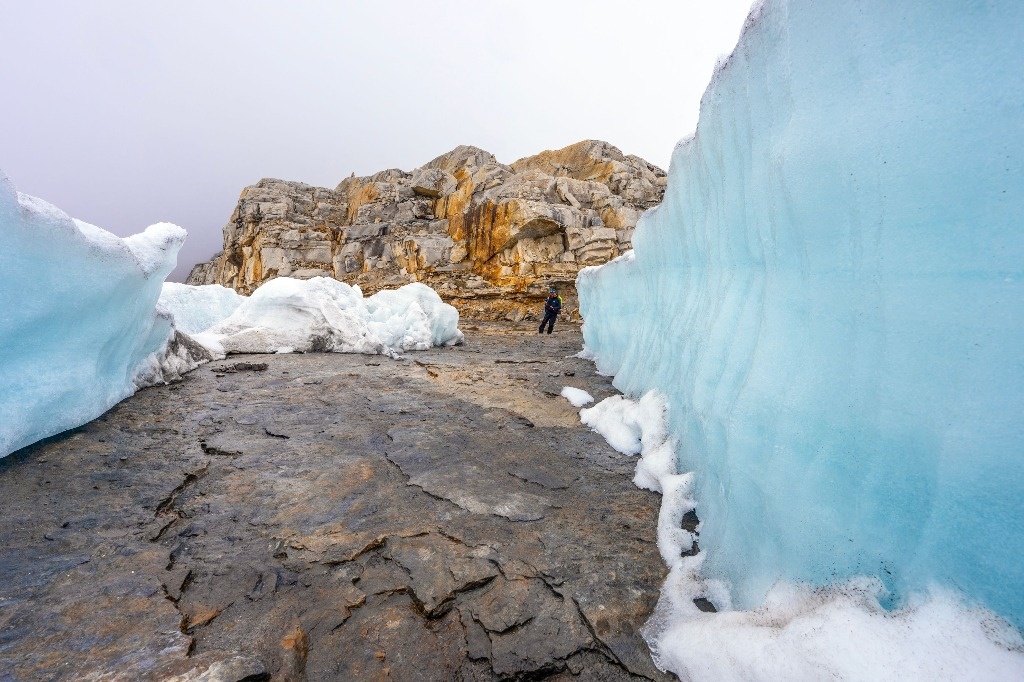Snowy El Cocuy. Until a few months ago, the Ritacuba Blanco glacier, one of the highest peaks in Colombia, was covered by a homogeneous blanket of snow. But the brutal phenomenon of El Niño cracked it, causing gigantic ditches, unprecedented signs of its agony.
Since November, when the temperature began to rise in the country as a result of the climatic event, the white layer began to disappear at a speed that experts from the Sierra Nevada El Cocuy, in the extreme east of the department of Bocayá, described as alarming.
In the lowest part of Ritacuba Blanco, about 4,950 meters above sea level, cracks measuring several meters appeared, AFP confirmed in a recent visit. The rock, which for centuries was hidden under snow, was exposed.
Authorities blame El Niño, a natural phenomenon caused by the warming of the Pacific Ocean, which has hit Colombia since the end of 2023. The country, one of the most biodiverse in the world, recorded the hottest month in its history in March, with temperatures of up to 42.4° C in some areas.
“The El Niño phenomenon is perhaps the worst thing that can happen to our Colombian snow-capped mountains or glaciers since there is an absence of cloud cover and therefore snow does not fall on the glaciers, which is what we need for them to remain,” explains Jorge. Luis Ceballos, glaciologist at the state Institute of Hydrology, Meteorology and Environmental Studies (Ideam).
Ritacuba Blanco is the most broken of the country’s snow-capped peaks, counting down towards extinction. As it thaws drop by drop, tourists visit it and pose for photographs between the high walls of the cracks. Of the 14 tropical glaciers that existed in Colombia at the beginning of the 20th century, only six remain.
“At the end of last year in this place the walls measured approximately six meters” but now “it is practically not even one meter, the amount of ice” that has been lost in the last “six months” is quite a lot,” says Edwin Prada, worried. a local guide.
They perish
El Niño accelerated the disappearance of the glaciers of El Cocuy, a cold paradise where rivers are born and which can only be reached after a seven-kilometer hike uphill.
These mountains are home to condors and mammals such as tapirs and deer.
According to 2022 figures, some 12.8 km2 of that territory were then covered in ice and snow, the smallest area since Ideam monitored the data. In 2010 it was 16.5 km2 and in 2003 it was 19.8 km2.
In recent months “the snow melted due to the lack of precipitation, the ice was exposed to solar radiation and this accelerated the melting of the ice,” says Ceballos, the main authority on the subject in Colombia.
“We observed a change in ice thickness between 2 and 3 meters (…) that for a Colombian glacier is too much,” he adds.
In 2023 the planet experienced the highest temperatures on record, according to the European Copernicus Climate Observatory (C3S). The UN estimates that 2024 the world could break that record.
Glaciers, faithful thermometers of global warming, give warning signals. In Asia, the continent most affected by extreme heat, the frozen peaks of the Himalayas are also perishing, threatening the region’s water security, according to the World Meteorological Organization (WMO).
As reported by the Copernicus observatory this Wednesday, El Niño is “weakening”, allowing a glimpse of a possible respite later in the year, but without changing the fundamental trend of warming fueled by the massive use of oil, coal and fossil gas.
“Sadness”
In January, El Niño caused fires that devastated part of the emblematic hills of Bogotá. That month, the fire consumed more than 17 thousand hectares of forest throughout the country.
Some of the flames reached the paramos, fragile ecosystems unique to Andean countries whose frailejones (typical vegetables) were burned. Small lagoons that supply water to towns also dried up there.
In an unprecedented decision in this century, the Colombian capital decreed rationing in the aqueduct service three weeks ago due to the low level of its reservoirs.
Humberto Estepa, a resident of Güicán, a town near the glacier, shudders every time he climbs Ritacuba Blanco.
The thaw “was not as noticeable as now, this year the thaw has been too much,” he maintains.
“This year, every time I go up it is worse, there is already a new crack, more thawed (…) one feels very nostalgic as a resident here,” he laments.
Luisa Cepeda, a 39-year-old doctor, walked with her teenage daughter to see the sunset of the glacier. “I wanted to meet it, I didn’t want to miss it before it was over (…) it’s sad to see how it is fractured,” she says.
#Glacier #broke #due #high #temperatures #Colombia
– 2024-05-09 16:52:38
